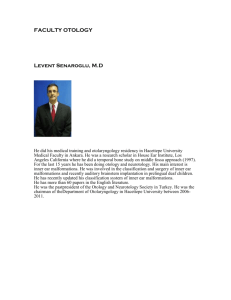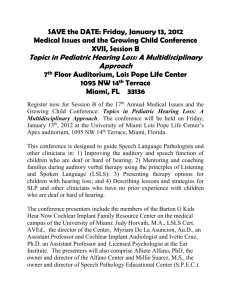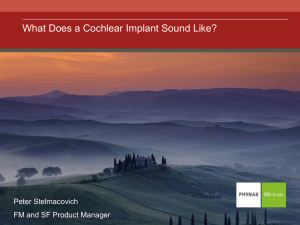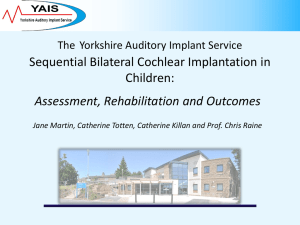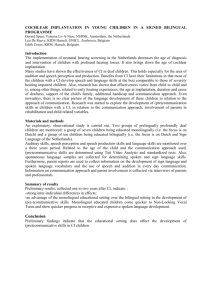PHS 398/2590 (Rev. 06/09) - Vanderbilt University Medical Center
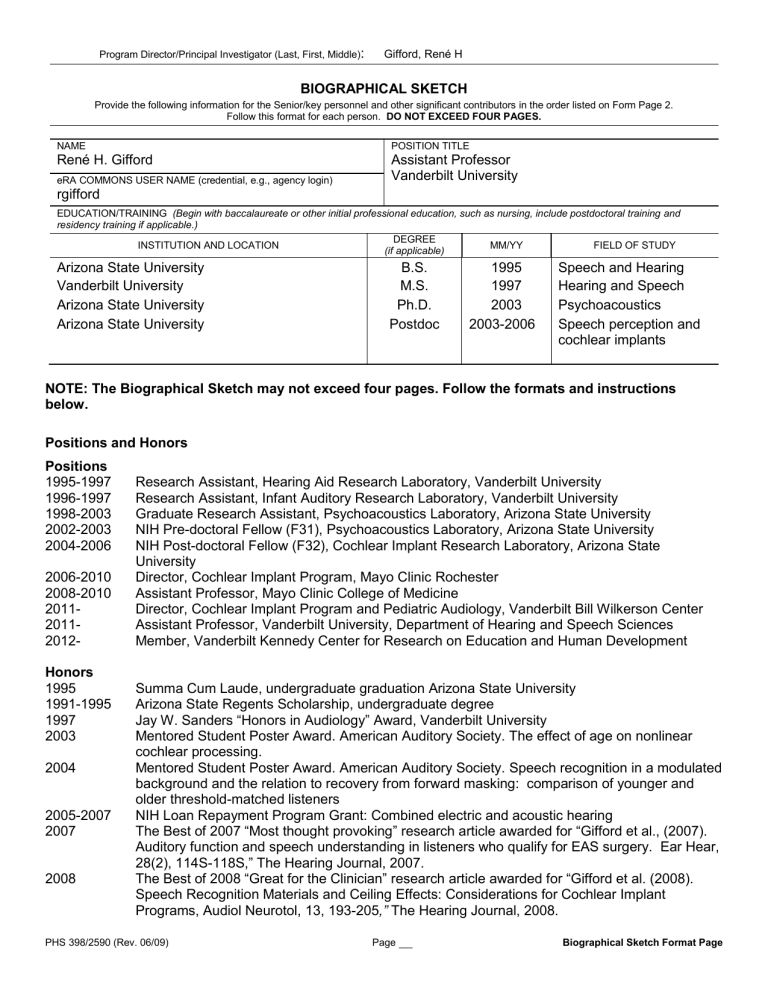
Program Director/Principal Investigator (Last, First, Middle)
: Gifford, René H
NAME
BIOGRAPHICAL SKETCH
Provide the following information for the Senior/key personnel and other significant contributors in the order listed on Form Page 2.
Follow this format for each person. DO NOT EXCEED FOUR PAGES.
René H. Gifford
POSITION TITLE
Assistant Professor
Vanderbilt University eRA COMMONS USER NAME (credential, e.g., agency login) rgifford
EDUCATION/TRAINING (Begin with baccalaureate or other initial professional education, such as nursing, include postdoctoral training and residency training if applicable.)
INSTITUTION AND LOCATION
DEGREE
(if applicable)
MM/YY FIELD OF STUDY
Arizona State University
Vanderbilt University
Arizona State University
B.S.
M.S.
Ph.D.
1995
1997
2003
Speech and Hearing
Hearing and Speech
Psychoacoustics
Arizona State University Postdoc 2003-2006 Speech perception and cochlear implants
NOTE: The Biographical Sketch may not exceed four pages. Follow the formats and instructions below.
Positions and Honors
Positions
1995-1997 Research Assistant, Hearing Aid Research Laboratory, Vanderbilt University
1996-1997 Research Assistant, Infant Auditory Research Laboratory, Vanderbilt University
1998-2003 Graduate Research Assistant, Psychoacoustics Laboratory, Arizona State University
2002-2003 NIH Pre-doctoral Fellow (F31), Psychoacoustics Laboratory, Arizona State University
2004-2006 NIH Post-doctoral Fellow (F32), Cochlear Implant Research Laboratory, Arizona State
University
2006-2010 Director, Cochlear Implant Program, Mayo Clinic Rochester
2008-2010 Assistant Professor, Mayo Clinic College of Medicine
2011- Director, Cochlear Implant Program and Pediatric Audiology, Vanderbilt Bill Wilkerson Center
2011-
2012-
Assistant Professor, Vanderbilt University, Department of Hearing and Speech Sciences
Member, Vanderbilt Kennedy Center for Research on Education and Human Development
Honors
1995 Summa Cum Laude, undergraduate graduation Arizona State University
1991-1995 Arizona State Regents Scholarship, undergraduate degree
1997 Jay W. Sanders “Honors in Audiology” Award, Vanderbilt University
2003 Mentored Student Poster Award. American Auditory Society. The effect of age on nonlinear cochlear processing.
2004 Mentored Student Poster Award. American Auditory Society. Speech recognition in a modulated background and the relation to recovery from forward masking: comparison of younger and older threshold-matched listeners
2005-2007 NIH Loan Repayment Program Grant: Combined electric and acoustic hearing
2007 The Best of 2007 “Most thought provoking” research article awarded for “Gifford et al., (2007).
2008
Auditory function and speech understanding in listeners who qualify for EAS surgery. Ear Hear,
28(2), 114S-118S ,” The Hearing Journal, 2007.
The Best of 2008 “Great for the Clinician” research article awarded for “Gifford et al. (2008).
Speech Recognition Materials and Ceiling Effects: Considerations for Cochlear Implant
Programs, Audiol Neurotol, 13, 193-205 ,” The Hearing Journal, 2008.
PHS 398/2590 (Rev. 06/09) Page Biographical Sketch Format Page
2008
2009
Program Director/Principal Investigator (Last, First, Middle)
: Gifford, René H
The Best of 2008 “Most thought provoking” research article awarded for “Gifford et al., (2008).
Hearing preservation surgery: Psychophysical estimates of cochlear damage in recipients of a short electrode array, J Acoust Soc Am, 124, 2164-2173 .
” The Hearing Journal, 2008.
The Best of 2009 “Most thought provoking” research article (Co-author) awarded for “Dorman et al. (2009). Word recognition following implantation of conventional and 10 mm Hybrid electrodes. Audiol Neurotol, 14:181-189 .
” The Hearing Journal, 2009.
Selected Peer-reviewed Publications (selected from 36 peer-reviewed publications)
1. Gifford RH, Dorman MF, Spahr AJ, Bacon SP. (2007). Auditory function and speech understanding in listeners who qualify for EAS surgery. Ear Hear , 28(2), 114S-118S. PMID: 17496661
2. Dorman MF, Spahr AJ, Gifford RH, Holden T, Skinner M, Finley C, Loiselle L, McKarns SA. (2007). An electric frequency-to-place map for a cochlear implant patient with near-normal hearing in the non-implanted ear. J Assoc Res Otolaryngol, 8, 234-240. PMID: 17351713
3. Gifford RH, Bacon SP, Williams EJ. (2007). An examination of speech recognition in a modulated background and of forward masking in younger and older listeners. J Speech Lang Hear Res , 50, 857-864.
PMID: 17675591
4. Gifford RH, Dorman MF, Spahr AJ, McKarns SA. (2007). Combined electric and contralateral acoustic
hearing: word and sentence intelligibility with bimodal hearing. J Speech Lang Hear Res , 50, 835-843.
PMID: 17675589
5. Dorman MF, Gifford RH, Spahr AJ, McKarns SA. (2008). The benefits of combining acoustic and electric stimulation for the recognition of speech, voice and melodies. Audiol Neurotol , 13, 105-112. PMID:
18057874
6. Gifford RH, Shallop JK, Peterson AM. (2008). Speech Recognition Materials and Ceiling Effects:
Considerations for Cochlear Implant Programs. Audiol Neurotol , 13, 193-205. PMID: 18212519
7. Gifford RH, Dorman MF, Spahr AJ, Bacon SP, Skarzynski H, Lorens A. (2008). Hearing preservation surgery: Psychophysical estimates of cochlear damage in recipients of a short electrode array. J Acoust Soc
Am , 124, 2164-2173. PMID: 19062856
8. Gifford RH, Revit LR. (2010). Speech perception for adult cochlear implant recipients a realistic background noise: effectiveness of preprocessing strategies and external options for improving speech recognition in noise.
J Am Acad Audiol , 21(7):441-51. PMID: 20807480
9. Gifford RH, Dorman M F, Shallop JK, Sydlowski, SA. (2010). Evidence for the expansion of adult cochlear implant candidacy. Ear Hear, 31:186-94. PMID: 20071994
10. Gifford RH, Dorman, MF, Brown, CB. (2010). Psychophysical properties of low-frequency hearing: implications for perceiving speech and music via electric and acoustic stimulation. Adv Otorhinolaryngol,
67:51-60. PMID: 19955721
11. Carlson MC, Gifford RH, Driscoll CLW, Service G, Hughes-Borst B, Tombers N, Olund AP. (2011).
Implications of minimizing trauma during conventional length cochlear implantation. Otol Neurotol ,
32(6):962-8. PMID: 21659922
12. Gifford RH, Olund AP, DeJong MD. (2011). Improving speech perception in noise for children with cochlear implants. J Am Acad Audiol . 22(9):623-32. PMID: 22192607
13. Breneman A, Gifford RH, DeJong MD. (2012). Cochlear Implantation in Children with Auditory Neuropathy
Spectrum Disorder: Long Term Outcomes. J Am Acad Audiol . 23(1):5-17. PMID: 22284837
14. Noble JH, Gifford RH, Labadie RF, Dawant BM. (2012). Statistical shape model segmentation and
frequency mapping of cochlear implant stimulation targets in CT. Med Image Comput Comput Assist Interv .
15(Pt 2):421-8. PMID: 23286076
15. Gifford RH, Dorman MF, Skarzynski H, Lorens A, Polak M, Driscoll CLW, Roland P, Buchman CA. (2013).
Cochlear implantation with hearing preservation yields significant benefit for speech recognition in complex
listening environments. Ear Hear . Epub ahead of print. NIHMSID: 430187
PHS 398/2590 (Rev. 06/09) Page Continuation Format Page
Program Director/Principal Investigator (Last, First, Middle)
: Gifford, René H
Research Support
Ongoing Support
R01DC009404 (PI)
Title: Cochlear implants: combined electric and binaural acoustic stimulation 12/2009-11/2014
Goal: The goal of this study is to determine the efficacy of binaural hearing preservation for speech recognition in complex listening environments and spatial resolution in adult cochlear implant recipients.
R01DC010821 (co-PI)
Title: Cochlear Implant performance in Realistic Listening Environments 07/2010-06/2015
Goal: The goal of this study is to assess speech recognition performance for unilateral and bilateral implant recipients in both standard and simulated realistic test environments, with the goal of creating a decision matrix that links data that can be easily collected in the clinic, e.g., CNC scores in quiet and the amount of residual hearing, with data that cannot be collected in the clinic, i.e., performance data collected with multiple, spatially separated loudspeakers
R21 DC012620 (co-I)
Title: Image-based frequency reallocation for optimizing cochlear implant programming 07/2012-06/2014
Goal: The goal of this study is to develop and assess the clinical utility of an image-guided approach for determining the position of implanted cochlear implant electrodes relative to stimulation targets [the nerves of the Spiral Ganglion (SG)] for cochlear implant programming assistance.
PHS 398/2590 (Rev. 06/09) Page Continuation Format Page

